This week we shall take a tour to the Vigeland sculpture park in Oslo. The Vigeland Park is the world’s largest sculpture park made by a single artist, and is one of Norway’s most popular tourist attractions. The park is open to visitors all year round.
The Main Gate in granite and wrought iron facing Kirkeveien marks the beginning of the 850 meter long axis that leads over the Bridge to the Fountain on to the Monolith and ends in the Wheel of life. The Main Gate consists of five large gates and two small pedestrian gates in wrought iron. Railings curve outwards on each side and end in two copper-roofed gate houses, topped by guilded weather vanes.
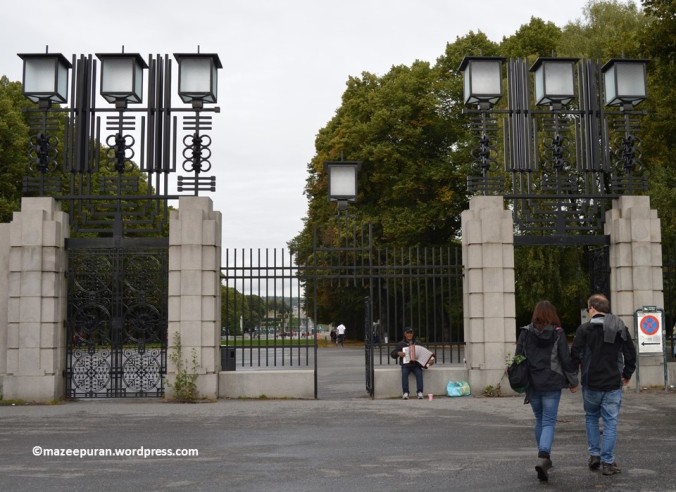
The gates were designed in 1926. The upper parts, surmounted by lanterns, were redesigned in the 1930’s to replace the older ones. The wrought iron was carried out in a forge which was constructed next to the Vigeland Museum, south of the park. The Main Gate was erected in 1942 and was financed by a Norwegian bank.
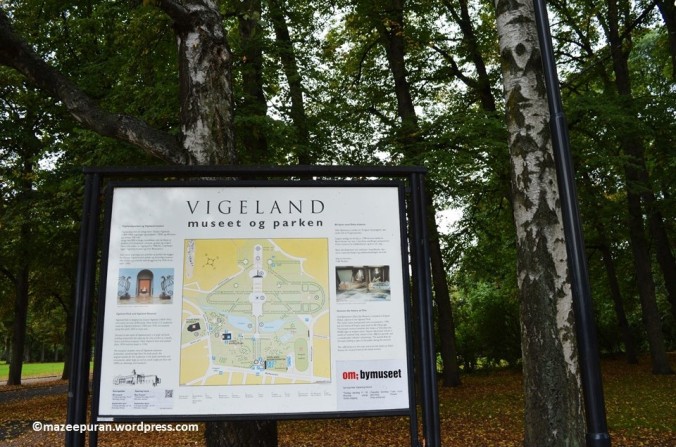
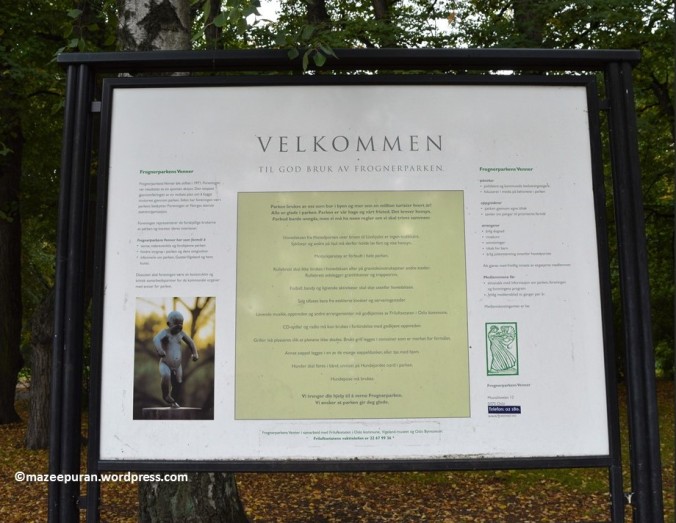 The unique sculpture park is Gustav Vigeland’s lifework with more than 200 sculptures in bronze, granite and wrought iron. Vigeland was also in charge of the design and architectural layout of the park. The Vigeland Park was mainly completed between 1939 and 1949.
The unique sculpture park is Gustav Vigeland’s lifework with more than 200 sculptures in bronze, granite and wrought iron. Vigeland was also in charge of the design and architectural layout of the park. The Vigeland Park was mainly completed between 1939 and 1949.
Most of the sculptures are placed in five units along an 850 meter long axis: The Main gate, the Bridge with the Children’s playground, the Fountain, the Monolith plateau and the Wheel of Life.
To the north inside the Main Entrance stands Vigeland’s self-portrait (1942). Dressed in his everyday working clothes, with hammer and chisel in hand, he stands as a signature of his own work.
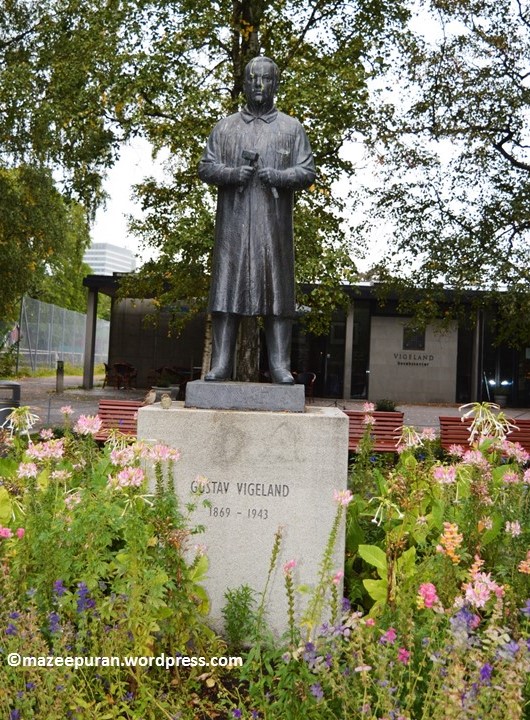
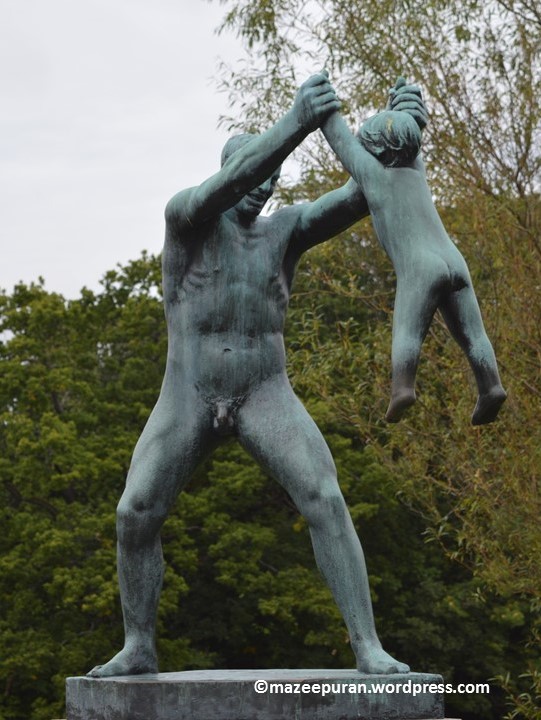
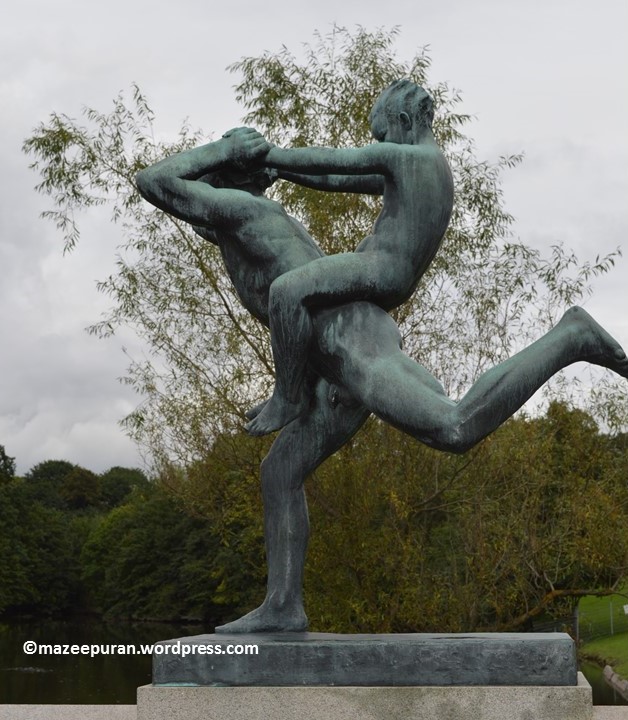
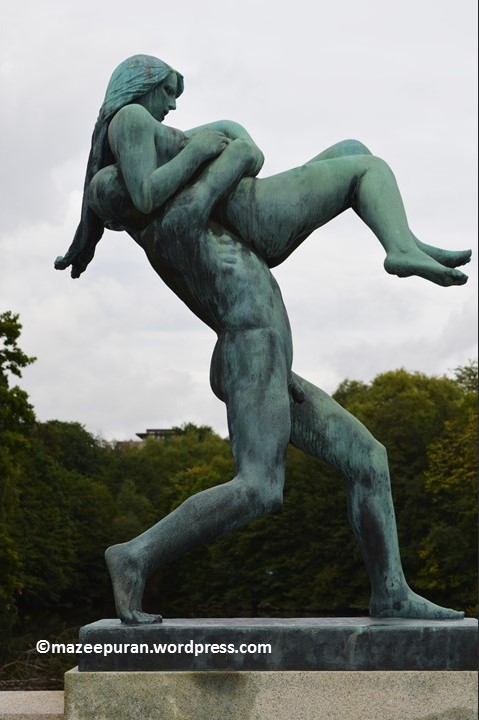
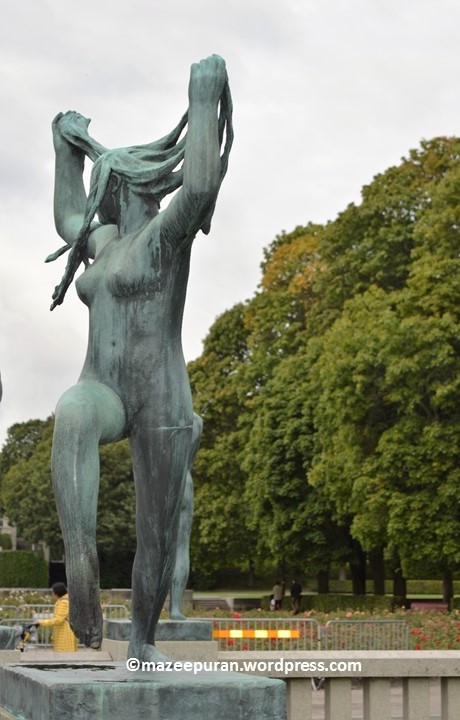

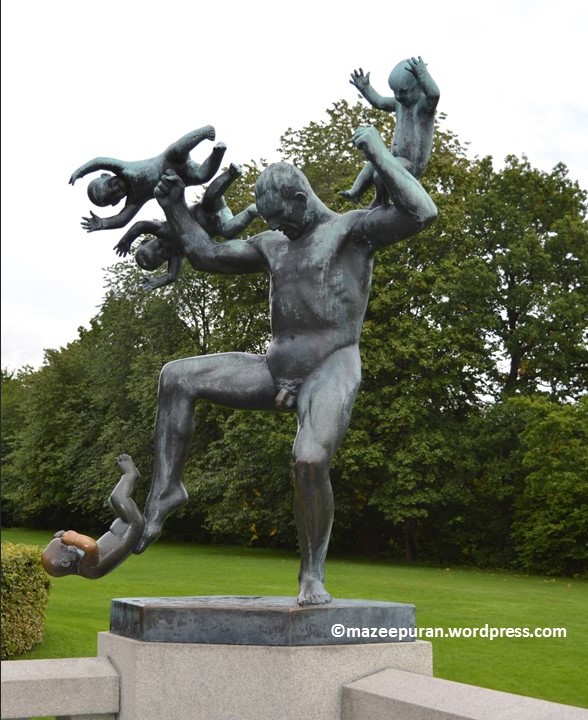
Among the sculptures in the park the Fountain has the longest history. The idea of a monumental bronze fountain had occupied the mind of Vigeland since the turn of the century. A sketch in plaster, that resembles today’s fountain, attracted great enthusiasm when exhibited in 1906.
Around the first world war Vigeland enlarged his fountain project with a number of large granite groups. And in 1919 an enormous granite column also had become part of the plan. It was not until 1924, when the city left the Frogner fields to Vigeland, that the fountain found its final location. Some changes were made from the original sketch.
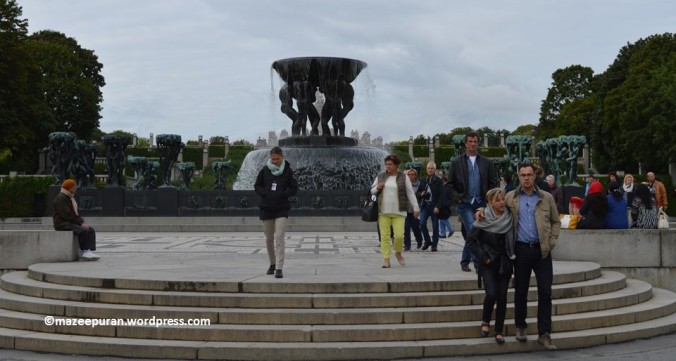
The 20 tree groups were all modelled between 1906 and 1914. Beneath the crown of the trees the life of man, from cradle to grave, unfolds. Our time on earth is at the same time only a part of an eternal cycle with no beginning and no end. After the tree group with the skeleton which is about to decay in nature, follows a tree full of children: From death arises new life.
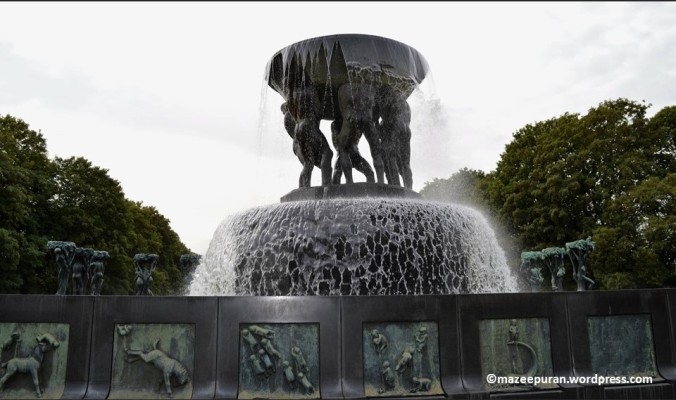
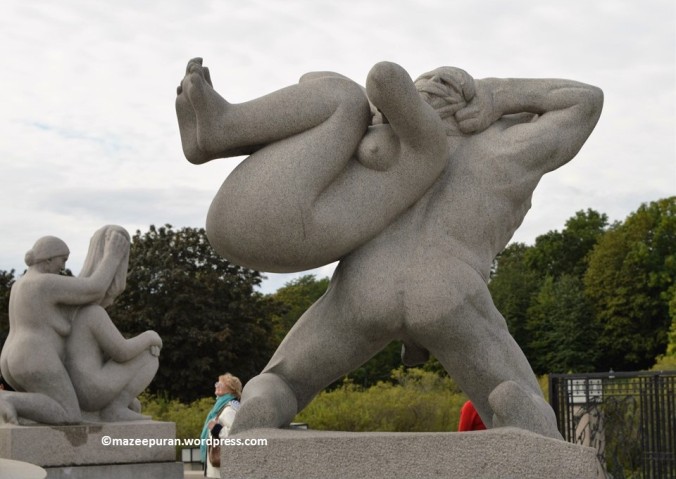
This tour was inspired by Jo’s Monday walk theme and since we see different actions in these sculptures, I thought it’s a good idea to link it to this week’s lens-artists-photo-challenge.
In earlier posts, I have exhibited various sculptures in the park, like in The Monolith.
The information given in the post is taken from park’s website References: http://www.vigeland.museum.no/en/vigeland-park
Just wow
LikeLiked by 2 people
Thank you so much Paul.
LikeLiked by 1 person
You’re very welcome
LikeLiked by 1 person
Thank you Rupali. This makes me wanting to go there. Fabulous clicks also
LikeLiked by 2 people
Awe, who days one day you might. Thank you Kurian.
LikeLiked by 1 person
Thank you Rupali. Yes one day 👍
LikeLiked by 1 person
Oh Rupali this is my most favourite park! I have risked breaking my neck on the icy paths in winter just to get more shots … it so cleverly depicts the ambiguity of life …
LikeLiked by 2 people
You are right Kate. It’s a unique park. HAve you shared some photos? Send me the link, I would love to see.
Thank you!
LikeLiked by 1 person
No I’m talking about decades ago when we only used film … the few photos I managed to keep are too expensive to digitise … now I have paid work we shall see. Too much going on just now but you’ve planted a seed.
LikeLiked by 1 person
We shall wait.
Have a good evening Kate.
LikeLiked by 1 person
you too Rupali 🙂
LikeLiked by 1 person
Good link for Action! 🙂 🙂 I’ve never heard of him but his work is so exuberant, Rupali. Many thanks for sharing it with me.
LikeLiked by 2 people
Thank you for inspiring and appreciating me.
LikeLiked by 1 person
What a cool garden, Rupali. “An eternal cycle with no beginning and no end…” — I am surprised to read this (brought a smile to my face 😉
Have a great day.
LikeLiked by 2 people
Thank you for being positive with the post Helen.
LikeLiked by 1 person
Wow..just wow…..makes me wanna go there
LikeLiked by 1 person
Thank you so much such positive comment.
Start planning a trip for 2019 🙂
LikeLiked by 1 person
Funny that a stationery statue should depict action but indeed they do Rupali!!
LikeLiked by 2 people
That’s the beauty Tina. Thank you.
LikeLike
So beautiful Rupali, thanks for sharing!!!
LikeLiked by 1 person
Thanks for appreciation Paulo.
LikeLiked by 1 person
Amazing architecture
LikeLiked by 1 person
Yes indeed and most important it’s one man show. Thank you Deepak.
LikeLiked by 1 person
So wonderful, Rupali! Thank you for taking us on the walk with you via your photos! The fountain is so amazing!
HUGS!!! 🙂
LikeLiked by 1 person
I am glad you like the walk Carolyn. It’s all my pleasure to take you with me.
LikeLiked by 1 person
Good results on a dull day
LikeLiked by 1 person
Now you point it correct Derrick. Thank you.
LikeLiked by 1 person
Waah….kyaa khubsurat drishya…behtarin.👌👌
LikeLiked by 1 person
Ek insan ke athak parishram ka fal aaj hum dekh rahe hain.
Shukriya apka!
LikeLike
Mananaa padegaa…..Dashrath Manjhi duniyan me aur bhi hain….bahut khub.
LikeLiked by 1 person
Ji sahi kaha bas hame pata nahi hota.
Dhanyawaad.
LikeLike
Very nice place to see. I’ll surely enjoy if I’m going there. Great pieces of art! 🙂
LikeLiked by 1 person
I am sure you will. Thank you for commenting.
LikeLike
Your photos have done complete justice to the beauty of the statues Rupali 👍
LikeLiked by 1 person
Thank you Radhika.
LikeLiked by 1 person
Very informative, loved the sculptures and the clicks.
LikeLiked by 1 person
Thank you for your feedback Jyotirmoy.
LikeLiked by 1 person
Wow! Awesome sculptures. Thanks for sharing.
LikeLiked by 1 person
Thanks again and again. Have a nice weekend.
LikeLiked by 1 person
Thanks. You too.
LikeLiked by 1 person
Truly Amazing. Loved sculptures.
LikeLiked by 1 person
Yes the sculptures are amazing. Thanks for checking the images.
LikeLiked by 1 person
Pingback: Jo’s Monday walk : A tale of three castles- 2. Alnwick | restlessjo
Thank you for the link Jo
LikeLike